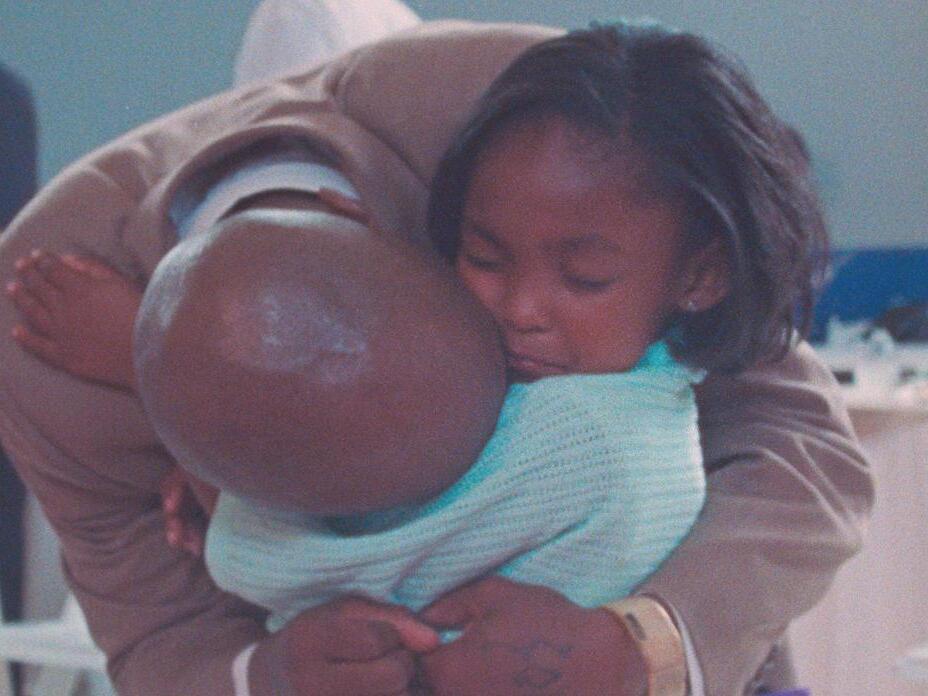Physical Address
304 North Cardinal St.
Dorchester Center, MA 02124
Physical Address
304 North Cardinal St.
Dorchester Center, MA 02124

In a correctional facility in Washington DC, a group of fathers, dressed in smart suits, anxiously awaits. They sit on plastic chairs, adjusting their ties and craning their necks in anticipation. The door finally swings open, and a parade of young girls in prom dresses makes its way down the hallway. Their incarcerated fathers have been permitted, just for this day, to change out of their jumpsuits.
“It gets you when they walk down the hallway,” says Angela Patton, the co-director of Daughters, a striking new documentary that follows four daughters and their incarcerated fathers as they prepare for a daddy-daughter dance. Seeing the girls walk down that corridor, eyes searching frantically for their dads, some of whom they haven’t hugged in years, is profoundly moving.
Patton, a community activist from Richmond, Virginia, has organized 13 of these dances since 2008. Even though she has attended many, she says it’s always emotional. “Each time, I have to excuse myself and go to the ladies’ room and get myself together,” Patton shares.
Premiering at the Sundance film festival earlier this year, the documentary won two audience awards: for best documentary and overall festival favorite. Its emotional power was so compelling that Netflix acquired it just days later.
After giving a TED Talk about the dances in 2012, Patton was approached by several filmmakers, all men, wanting to document the outreach program she founded. “I could tell their willingness to work with me was all about ‘I need access to the prison,’” she recalls. They aimed to focus on the fathers and their incarceration reasons, but Patton believed the story belonged to the daughters. It was their idea to bring the dance into the jail, and their letter to the then Richmond city sheriff helped make the first dance happen. “I’m not going to be a dream crusher,” says Patton, who personally delivered the letter.
Natalie Rae, the film’s co-director, was deeply moved by Patton’s TED Talk, saying, “I had goosebumps, I was crying, and my heart was pounding.” Rae admired Patton’s approach to listening to young people “like they’re equals.”
The documentary was made over eight years, although it wasn’t until 2019 that they found their protagonists. The film features Aubrey, a bubbly five-year-old; Santana, a 10-year-old with righteous fury over her dad’s absence; Ja’Ana, an 11-year-old eager to see her father but who barely remembers him; and Raziah, a 15-year-old high schooler struggling with mental health.
The girls feel a mix of excitement and trepidation, with longing tinged with skepticism. Patton and Rae focus on their silent emotions, too, translating their energy for the screen. A scene featuring Santana on roller skates uses bold neon lighting to depict her intense inner life. They aimed to show various ways of coping with having an incarcerated parent.
“This isn’t a prison rehabilitation film,” Rae clarifies. “It’s about the bravery these girls had to find forgiveness.” However, similar to films like Time (2020), The Work (2017), and 13th (2016), Daughters makes a passionate case for humane treatment of inmates and consideration for their families.
Rae, who had never been to a jail before, found her expectations subverted. The dads, emotional and reflective, must complete a 10-week counseling course to attend the dance. The film’s “healing circles” take place in a light-filled chapel, emphasizing their humanity by withholding specifics about their sentences. “They’re asking for forgiveness and trying to forgive themselves first,” Patton explains.
The fathers are portrayed as gentle and eloquent, far from the “hardcore” image often associated with them. The film reveals that 95% of fathers who complete the program do not reoffend, highlighting the powerful effect of being able to hug and dance with their daughters. Touch, Rae emphasizes, calms the nervous system and prevents a fight-or-flight response.
However, “touch visits,” allowing physical contact with loved ones, are increasingly replaced by video visits, driven by cost-cutting measures rather than COVID-19 concerns. “It’s profiting from family separation,” Rae criticizes, as many children are so dismayed by the poor-quality video calls that they don’t return.
The documentary honors the uniqueness of the dance by filming it on 16mm film stock, capturing light and emotion with authenticity. Fathers present corsages, make earnest promises, and dance to “Before I Let Go” by Frankie Beverley and Maze. Through their tears, the girls encourage their fathers to be brave.
The film’s climax doesn’t end with the dance. Instead, Rae and Patton continue to follow the girls, some of whose fathers have since been released. “People want to know if they’ve made it,” says Patton. But it’s more real to see some of Aubrey’s sparkle dimming as she accepts her reality at age seven.
Upon seeing the final film, the girls cringed at their younger selves. “Typical teenage girls’ responses,” laughs Patton. Aubrey, now 10, found herself annoying in the past footage, and Raziah, who battles depression, was perturbed at being seen crying on film.
Nevertheless, Patton and Rae believe that sharing their stories has been cathartic for the girls, helping to strip away the stigma of having an incarcerated parent. “You don’t leave feeling sorry for them,” says Patton. “You see that they’re going to be OK.”
Daughters is on Netflix from 14 August.
Source: The Guardian



